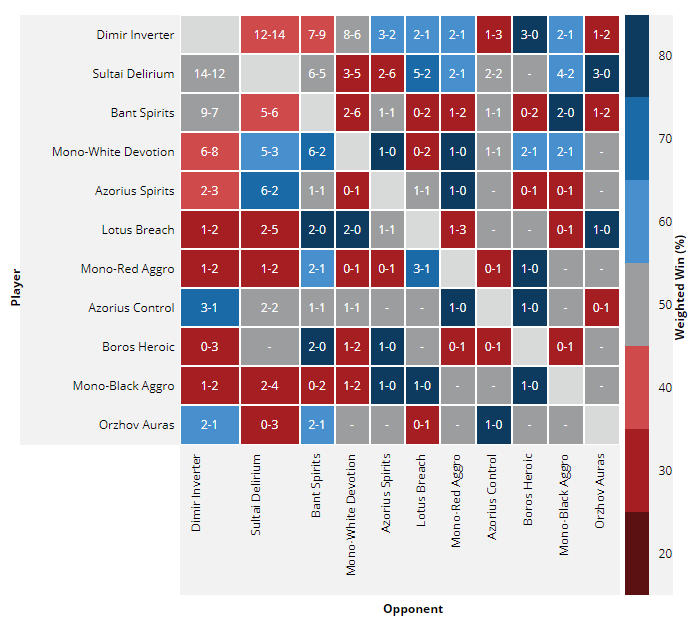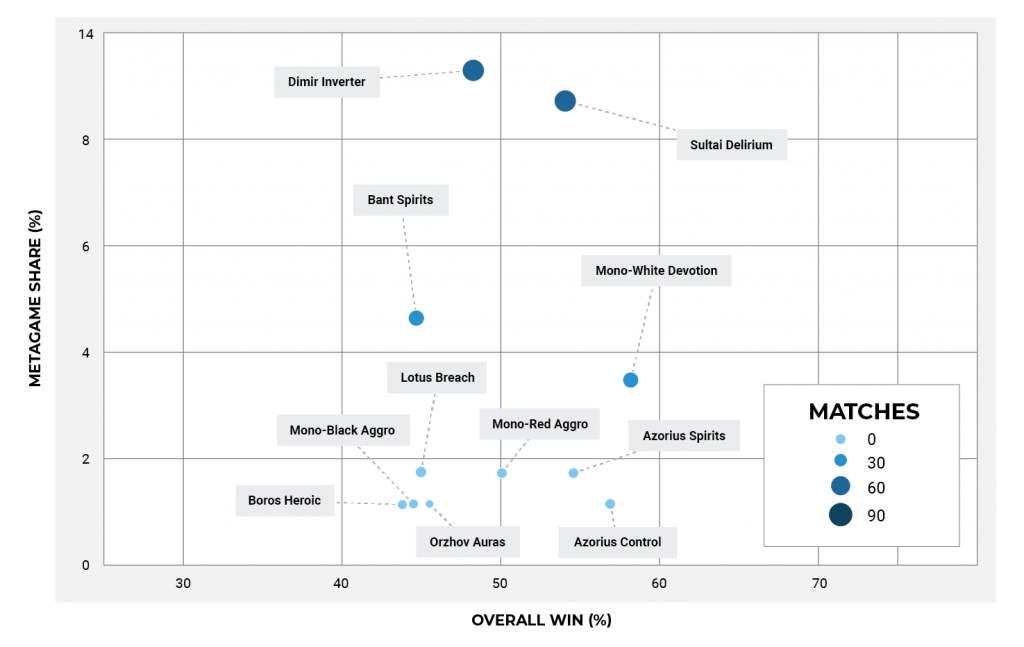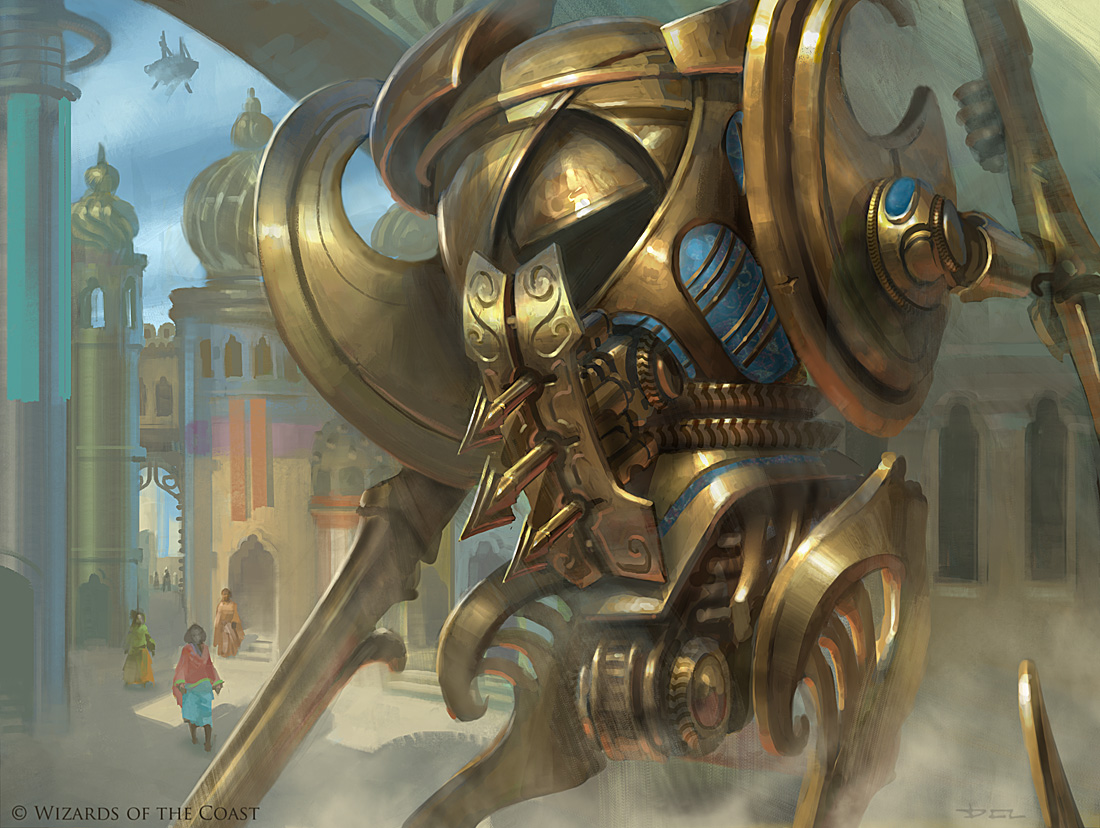Welcome back to Mox Insights! We’re excited to bring you a breakdown of the first solo SCG event for 2020, as team tournaments kicked off Season One of the SCG Tour. We get to sink our teeth into the newest format in Magic right now, Pioneer, a format fresh off of Players Tour Phoenix, moving and adapting around what is regarded by someone as a savior and others as the boogeyman: Dimir Inverter. While, as per usual, we only have a small sample size of decks, Day 2 of SCG Indianapolis tells an interesting story. As a bonus, we also crunched some numbers also from Players Tours Brussels, Phoenix, and Nagoya, just to put some additional context on SCG Indianapolis’s result. Let’s dive in.

Surprising absolutely no one, Dimir Inverter was the most popular deck of the tournament. It is the pillar that Pioneer currently revolves around, taking up half of the Top 8. Despite this, its win rate is not anything out of the ordinary, posting barely 50% at the Players Tours and slightly under that for SCG Indianapolis. One can very reasonably say it’s a popular deck and as popular decks saturate the metagame, their win rate should naturally trend slightly downwards, both as new players pick up the deck and as the deck has more opportunities to lose game by virtue of its saturation of the metagame.
Where Dimir Inverter players stand to get the most benefit is a deep dive into the deck to understand the mirror. While there isn’t a strong performance difference between particular tech options such as Pack Rat or no Pack Rat, it seems that the more advanced players adapted to specific tech of maindeck Narset, Parter of Veils and integrating Hero’s Downfall in multiple copies into their 75s. Ironically, Dimir Inverter’s greatest strength is how building it towards fighting the mirror also seems to improve its matchup against the rest of the field. On paper, Mono-White Devotion is well-equipped with tools to fight Dimir Inverter, with maindeck copies of Gideon of the Trials. Yet we found that Mono-White Devotion, both at SCG Indianapolis and across the Players Tours, actually was a slight underdog to Dimir Inverter.
But the tournament cannot only be looked at through the lens of Dimir Inverter: there’s also Sultai Delirium. Looking at its matchup spread and overall win rate at SCG Indianapolis, as well as the three Players Tour events, it’s crucial that people understand that just as much as Dimir Inverter is shaping this format, Sultai Delirium is the other pillar of the format exerting pressure on it.

The main difference between Sultai Delirium and Dimir Inverter, on a larger-scale level, is that Sultai Delirium has slightly more polarizing matchups: it feasts on aggressive strategies, has a fighter’s chance against most other strategies, even Bant/Azorius Spirits decks, but heavily struggling against Mono-White Devotion, it’s only significantly bad matchup.
Sultai Delirium’s major weakness right now seems to be that it is tremendously customizable. Unlike the Dimir Inverter players, who get to determine how badly they want to win the mirror match and then give up small points against the rest of the format, Sultai Delirium still has a ways to go in finding what Gerry Thompson would call “the Truth” – Sultai Delirium is not in the crucible of being the best deck to play.
That said, Sultai Delirium is a fine midrange choice for anyone to bring to a tournament. Just consider where the metagame is moving and the countless sideboard options you have in Sultai colors: Witch’s Vengeance, Traverse the Ulvenwald or not. Sultai Delirium and Dimir Inverter, though, are the decks to have your deck selection built around. Together they comprised almost half the Day 2 metagame of SCG Indianapolis – you cannot afford to bring a deck that is bad against both of these decks. Which brings us to…
What Not to Play
Right now, we cannot in good conscience recommend that you play Mono-Red Aggro. As a Mono-Red player, you’re put in an unenviable squeeze: on one side, you have the surgical precision of Dimir Inverter taking apart your aggression card by card, and on the other, Sultai Delirium is battering your door down with Uro, Titan of Nature’s Wrath. For Mono-Red Aggro to be good right now, significant portion of the metagame will have to shift towards playing Spirits archetypes – consistent with our Players Tour data, Mono-Red Aggro at SCG Indianapolis best performed against those Spirits decks. Another hole for Mono-Red Aggro to try to fight through might involve Rampaging Ferocidon and targeting Mono-White Devotion. Mono-Red Aggro’s best matchup is Lotus Breach, a deck that simply isn’t setting the paces for Pioneer right now.
Just like Mono-Red Aggro, Mono-Black Aggro used to rule Pioneer but it has been dethroned. We cannot in good conscience recommend a deck that is even more poorly positioned against the “big two” – Sultai Delirium annihilated Mono-Black Aggro in the Players Tours, beating it 89% of the time. Much like Mono-Red Aggro, Mono-Black Aggro’s best matchups are against the Spirits decks.
Bant Spirits is another deck that is a popular choice but seems slightly suboptimal for the current metagame. Azorius Spirits did better overall, perhaps in the hands of better skilled pilots, but it might be that a green splash and Collected Company isn’t what makes the Spirits deck effective. That said, Azorius Spirits has to play Port Town. Pick your poison.
What To Try
While the results from SCG Indianapolis aren’t encouraging, we think that Lotus Breach deserves some more attention. In the combined data from the three Players Tours, Lotus Breach posted positive win rates against Sultai Delirium, Mono-White Devotion, and Dimir Inverter, three decks that have come to define the post-Players Tour Pioneer metagame. Your worst matchup in Mono-Red Aggro, especially the bigger midrange red style decks popularized by Todd Anderson, is being heavily suppressed by the Sultai Delirium and Dimir Inverter, leaving you space to make a run in a tournament.
The other angle of attack that we pointed out above is Mono-White Devotion. While the deck is anything but exciting – not even Legacy Death & Taxes players register eighteen Plains – its ability to attack Sultai Delirium alone makes it a worthy contender in the format. Having a combo finish in the deck seems to help insulate it against bad matchups while having the ability to go toe-to-toe with other midrange decks. Don’t sleep on this as a potential meta-breaker.
Pioneer’s Next Frontier
While some people are calling for a Dig Through Time ban as a power level nerf to Dimir Inverter, we would advocate that the format continue to evolve. As we’ve shown through repeated treks into the data of SCG and the formerly named Pro Tours (now Players Tours), the top 8 of these events is not anywhere near the full story of the event. If anything, it might be the time for unbannings. Straightforwardly aggressive decks like Mono-Red Aggro and Mono-Black Aggro are falling behind and could use a power boost – perhaps Smuggler’s Copter returns?
The next stop on the SCG Tour will be the SCG Baltimore Pioneer Open, which is plenty of time for a ban list announcement from Wizards of the Coast. We’ll see where the metagame has moved then.


